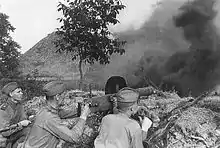| 280th Rifle Division | |
|---|---|
| Active |
|
| Country | Soviet Union |
| Branch | Red Army |
| Type | Rifle division |
| Engagements | World War II |
| Decorations | 2nd formation:
|
| Battle honours | |
| Commanders | |
| Notable commanders | Dmitry Golosov |
The 280th Rifle Division (Russian: 280-я стрелковая дивизия) was an infantry division of the Soviet Union's Red Army during World War II, formed twice. It was first formed in the summer of 1941 and destroyed in the Bryansk pocket in the fall of 1941. The division was reformed in late December, and served throughout the war before being disbanded in 1946.
History
First formation

The 280th began forming on 2 July 1941 near Tula in the Moscow Military District. Its basic order of battle included the 1031st, 1033rd, and 1035th Rifle Regiments, as well as the 840th Artillery Regiment and 583rd Sapper Battalion. After spending a month forming near Moscow, the division was assigned to the 24th Army of the Reserve Front on 5 August. Its headquarters was located at Slobodka, southeast of Smolensk. The division was transferred to the newly formed 50th Army of the Bryansk Front on 15 August. At the end of September, the division was trapped in the Bryansk pocket at the beginning of Operation Typhoon, the German assault on Moscow. Its headquarters was overrun and its commander, Sergei Danilov, captured. On 13 October elements of the 280th, fighting alongside remnants of the 148th Rifle Division and the 282nd Rifle Division, opened a 500-meter gap in the German encirclement west of Navlya.[1] A handful of men escaped, but the bulk of the division was destroyed in the pocket and it was officially disbanded on 18 October.[2]
Second formation

The second formation of the 280th began on 25 December near Stalingrad in the North Caucasus Military District. It used the same basic order of battle as the first formation, but added the 368th Anti-Tank Battalion. The division remained near Stalingrad until its March 1942 transfer to the Reserve of the Supreme High Command. In April the incomplete 280th Rifle Division transferred to the Bryansk Front reserve and the next month was assigned to the 48th Army. During June and July, the division received reinforcements from the Moscow Military District's 14th Reserve Rifle Brigade. In January 1943, the 280th was moved to the 13th Army, which was transferred to the Central Front in March. By 1 April it had become part of the 28th Rifle Corps, and later that month the division with its corps was moved to the 70th Army. The 280th fought in the Battle of Kursk in July to the north west of Kursk. It was transferred to the 60th Army's 77th Rifle Corps during the battle.[3] On 15 September 1943, it was awarded the Order of the Red Banner for its "exemplary fulfillment of command tasks...and valor and courage".[4]
In October, the army was transferred to the 1st Ukrainian Front, with which the 280th spent the rest of the war. As part of the 18th Guards Rifle Corps, the division transferred to the 1st Guards Army in March 1944. On 27 July the division returned to the 13th Army, with which it remained for the rest of the war. Initially assigned to the army's 47th Rifle Corps, the 280th transferred to the 24th Rifle Corps in September. By December it had become part of the 27th Rifle Corps. During the last weeks of the war the division moved back to the 24th Rifle Corps.[3] By the end of the war, the division's honorifics were "Konotop-Korosten, Order of the Red Banner, Order of Suvorov." The division was relocated to Liuboml in the Carpathian Military District with the 24th Rifle Corps, where it was disbanded in 1946.[5]
References
Citations
- ↑ Lopukhovsky 2013, p. 316.
- ↑ Sharp 1996a, pp. 58–59.
- 1 2 Sharp 1996b, pp. 107–108.
- ↑ Affairs Directorate of the Ministry of Defense of the Soviet Union 1967, p. 196.
- ↑ Feskov et al 2013, p. 471.
Bibliography
- Affairs Directorate of the Ministry of Defense of the Soviet Union (1967). Сборник приказов РВСР, РВС СССР, НКО и Указов Президиума Верховного Совета СССР о награждении орденами СССР частей, соединениий и учреждений ВС СССР. Часть I. 1920 - 1944 гг [Collection of orders of the RVSR, RVS USSR and NKO on awarding orders to units, formations and establishments of the Armed Forces of the USSR. Part I. 1920–1944] (PDF) (in Russian). Moscow. Archived from the original (PDF) on 2019-03-27. Retrieved 2017-12-30.
{{cite book}}: CS1 maint: location missing publisher (link) - Feskov, V.I.; Golikov, V.I.; Kalashnikov, K.A.; Slugin, S.A. (2013). Вооруженные силы СССР после Второй Мировой войны: от Красной Армии к Советской [The Armed Forces of the USSR after World War II: From the Red Army to the Soviet: Part 1 Land Forces] (in Russian). Tomsk: Scientific and Technical Literature Publishing. ISBN 9785895035306.
- Lopukhovsky, Lev (2013). The Viaz'ma Catastrophe, 1941: The Red Army's Disastrous Stand against Operation Typhoon. Translated by Stuart Britton. Solihull: Helion. ISBN 9781908916501.
- Sharp, Charles C. (1996a). The Soviet Order of Battle World War II: An Organizational History of the Major Combat Units of the Soviet Army. Vol. 9. West Chester, Ohio: George F. Nafziger. OCLC 258366685.
- Sharp, Charles C. (1996b). The Soviet Order of Battle World War II: An Organizational History of the Major Combat Units of the Soviet Army. Vol. 10. West Chester, Ohio: George F. Nafziger. OCLC 39214254.